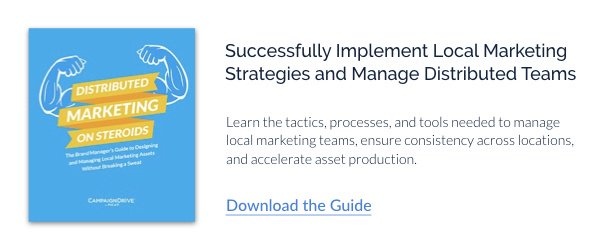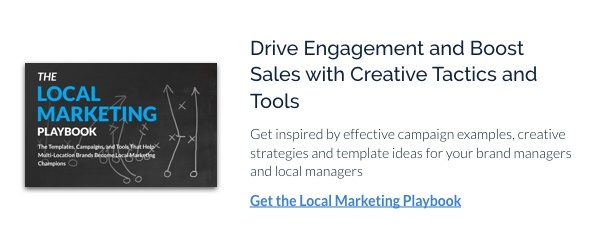According to a study published by Borrell Associates, co-op marketing's popularity among enterprise organizations and local franchisees is growing. But the amount of money that local affiliates are actually taking advantage of is $14Bn less than brands have earmarked for co-op marketing efforts in recent years. Why?
For many savvy multi-location brands, cooperative advertising is a key form of partnership between the enterprise organization and local franchisees or dealers that lets them share advertising costs. While co-op advertising policies differ from one organization to the next, most enterprise organizations will pay for a portion of the advertising costs and give the local affiliate guidelines on what to do (or, more importantly, what not to do) in their local marketing. These arrangements help franchisees and dealerships with all kinds of marketing, but they also do a great job of offsetting the costs that come with expensive media placements like television, radio, and out-of-home. So why don't more local affiliates take full advantage of this unique partnership?
For one, 25 percent of marketers indicate that their local affiliates don't follow brand guidelines. For any local affiliate, it can be incredibly frustrating when co-op advertisements are declined because they didn't follow design rules around logos, colors, or messaging. Additionally, marketers indicate that a lack of knowledge among local affiliates is a significant barrier to co-op marketing. Put simply, local marketers "don't know about" or "don't see co-op programs as valuable".
Despite the litany of challenges, enterprise organizations and local franchisees must realign their co-op marketing efforts to take full advantage of this valuable partnership opportunity. With $14Bn in extra advertising on the table, there's no reason not to!
Strategies to Enhance Your Co-Op Marketing Program
So the reasons for going after better co-op marketing are clear, but how can brands actually capture more of this local marketing pie with their dealers, franchisees or other partners and affiliates? The answer may not be exactly the same for every brand, but there are at least three main strategies for doing this that marketers should make their own.
#1 Make Local Compliance Easy
Co-op agreements often include hefty requirements that make it difficult for local partners to comply with the brand's guidelines. The more complex and specific enterprise organizations make the agreement, the more insurance they have against affiliates who might try to game the system. But this intricacy makes it especially difficult for local affiliates to understand what they're really getting out of the program – and what they might be getting themselves into. This leads to frustration for local affiliates who are less likely to see eye-to-eye with the brand. In fact, 38 percent of local businesses cite "too much paperwork" as the greatest barrier to using co-op marketing programs, and another 38 percent cited "too many rules." That's 76 percent who aren't using more co-op funds because they're overwhelmed with red tape!
What steps must brand managers take to secure local affiliate buy-in and streamline compliance with the co-op program? First, enterprise organizations must trim some of the legalese in the co-op agreement to make it easier for their local partners to understand. There's nothing worse than a co-op program that doesn't get high usage because of cumbersome or confusing technical terminology. Instead, draft a contract that, in layman's terms, articulates the true value of the cooperative program for local affiliates. If your lawyers insist on keeping the contract as-is, ask them if you can draft an executive summary or brief that helps franchisees understand exactly what they need to do to maximize their involvement in the program. They'll still have to sign the real paperwork, but at least you can give them the low-down on what it means and save them some time and frustration.
Secondly, brand managers must support their locations with brand-approved marketing material. Supplying pre-approved collateral guarantees that your affiliates will be in compliance with co-op rules and takes the burden off local marketers to figure out how to create their own marketing materials that will adhere to brand standards. Many of the world's most successful distributed brands leverage the power of Local Marketing Automation (LMA) to deploy and manage assets in a way that maximizes efficiency for co-op and also delivers the best return on creative.
By unlocking the power of CampaignDrive by Pica9, Marriott receives a $9 million ROI annually. Read the full case study here.
#2 Don't Underestimate Digital
Many co-op programs are geared towards merchandise, beautiful print marketing, and broadcast. These three channels have been effective for years and there's no disputing their popularity with brand managers and local marketers alike. In fact, a recent survey showed that 82 percent of brand managers said their co-op offerings include newspaper and 72 percent said they included direct mail and radio. However, only 37 percent report offering social media opportunities, and less than half offer cooperative email marketing programs. This disconnect from digital is one of the major drags on brands' co-op marketing programs.
Many local partners are looking for cheaper, more direct, and cost-effective ways to connect with the consumer. As a result, many are leaning on social media, email and mobile ads more than traditional channels. While many brands still aren't offering credit for digital as a component of their co-op marketing programs, those that are have positioned themselves for success. These digital-savvy brands encourage local affiliates to utilize online channels in their co-op programs which helps local affiliates target new audiences, captivate consumers and monitor campaign success at a more granular level.
"As consumer media attention continues to shift online, popular programs like the newspaper circular are losing steam. Given the sophistication of today's data aggregation and targeting technology, there is no reason that marketers cannot realize the benefit of shared customer marketing online," reports Chip Hall, SVP sales and marketing at Taracent Corp.
Brands running co-op advertising programs must embrace the new media landscape. Support local marketers' desire to experiment with digital by giving them access to localized web banners and optimized landing pages. Even better, consider offering co-op rebates for digital media spending to help your local marketers conquer digital marketing more affordably.
#3 Promote the Benefits of the Co-Op Program
Brand marketers know the benefits that cooperative marketing delivers to local partners and franchisees. However, they often fail to convey those benefits to their partners. This is a major reason that affiliates aren't using more of that $14Bn in the first place. If you don't tell your local partners what great things they can get out of the co-op program, they won't remember them. Local affiliates have to focus on generating sales or making payroll; you can't blame them if they don't think about the co-op program as much as you do. So spread the word!
Here are a few important things to consider when promoting the value of your co-op program:
- Consolidate all co-op program details into a simple package that local partners can decipher quickly
- Include digital offerings in your co-op program and talk to affiliates about the benefits of digital
- Track the performance of your best co-op marketers and use their successes to spread the word - ask them to talk to their peers about how they're hacking those co-op dollars
Your affiliates need to see the true benefit of the program. What will the cooperative marketing program actually do for them? How will the program attract customers? How much money does their store or location stand to save? Marketers must help their local affiliates understand that an effective co-op marketing program that aligns with the brand's core messaging will deliver exceptional results at the local level.
Local Marketing Software Can Help Brands Deliver Powerful Co-Op Marketing
Cooperative marketing is a great way to reduce marketing costs for local affiliates. However, brands that offer co-op marketing opportunities face many challenges, especially when it comes to the question of local autonomy vs. central control. There are a host of local marketing applications to make this process easier and more effective including co-op fund tracking tools, local marketing templates, digital asset management solutions, and more. Together, these distributed marketing tools enhance co-op marketing programs and deliver distributed marketing success.
Are you ready to maximize the effectiveness of your next co-op marketing initiative? Learn how brands like The Melting Pot, Marriott, and Polaris use local marketing automation software to support best-in-class co-op marketing experiences. Download The Local Marketing Playbook: The Templates, Campaigns, and Tools That Help Multi-Location Brands Become Local Marketing Champions.






